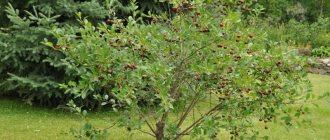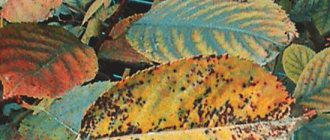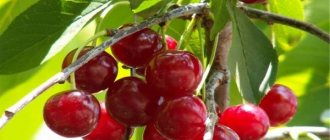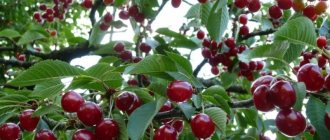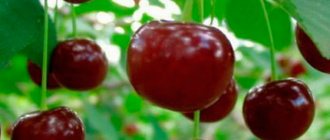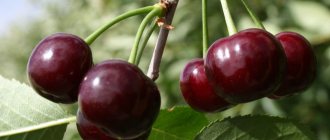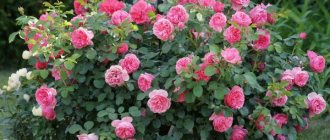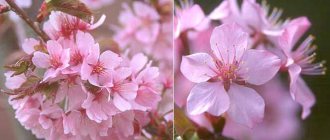What it is?
A dwarf (low-growing) variety is considered to be one whose maximum height is limited to 3 m. The following parameters are also characteristic of cherries:
- rapid growth and early fruiting;
- good yield;
- unpretentiousness.
Low cherries are actively used in intensive gardens. Such plants are convenient for mechanized harvesting .
Varieties of small trees and their characteristics
Below is a brief description of cherry varieties popular among domestic gardeners.
Miracle cherry
A hybrid of cherry and sweet cherry (duke), obtained from crossing Griot Ostheimsky and cherry Valery Chkalov. The berry is burgundy and huge - up to 10 g. The taste is sweet, juicy, with a distinct cherry aroma .
| Drought resistance, frost resistance | Drought resistant. Good winter hardiness of wood. The kidneys are damaged at -20 degrees in winter and are afraid of spring frosts. |
| Flowering and ripening period | Blooms in late April - early May. The harvest is ready for harvest in the second half of June. |
| Pollination | Self-sterile. The best pollinators: Tenderness, Iput, Donchanka cherries. |
| Productivity of the variety | It begins to bear fruit at the 4th year of life. Maximum yield (more than 12 kg per tree) occurs in 5-7 years. |
| Resistance to diseases and pests | Good resistance to fungal diseases. |
| Growing regions | Central region, Volga region and Moscow region. |
You can read more about Miracle Cherry here.
Bagryannaya
An old, proven cherry variety, with large fruits, a pleasant sweet and sour taste. Created in 1965, becoming the offspring of the Vladimirovka and Shubinka cherries.
| Drought resistance, frost resistance | The plant needs watering during the berry-filling phase, otherwise the fruits may fall off. Winter hardiness of wood is good, fruit buds are average. |
| Flowering and ripening period | Cherries bloom in the first half of May, the harvest ripens in early July. This is one of the fastest ripening domestic low-growing cherry varieties. |
| Pollination | Self-sterile. To create a harvest, cherries of the Shubinka and Griot Moskovsky varieties are planted near Bagryana. |
| Productivity of the variety | Productivity is average, up to 7 kg per tree. Crimson begins to bear fruit at the 3rd year of life. |
| Resistance to diseases and pests | In wet years it is affected by fungal diseases. |
| Growing regions | Central region, Volga region, southern regions of the country. |
Dwarf spank
An ancient cherry variety of folk selection, having several forms. The dwarf variety Shpanka is widely in demand by gardeners due to the excellent taste of its large scarlet berries.
| Drought resistance, frost resistance | The plant does not need watering. Winter hardiness up to -35 degrees. |
| Flowering and ripening period | Cherries bloom in the first half of May, the harvest ripens by mid-July. |
| Pollination | Self-sterile. Pollinators: Sania, Malyshka, Dessertnaya Morozova. |
| Productivity of the variety | Productivity up to 10 kg per tree. It begins to bear fruit at the 3rd year of life. |
| Resistance to diseases and pests | Average. |
| Growing regions | Central region, Volga region, Southern Urals. |
Saratov baby
A compact tree with dark red tasty berries was bred by Saratov breeders in 1995.
| Drought resistance, frost resistance | Not afraid of drought. The winter hardiness of wood and buds is high. |
| Flowering and ripening period | It blooms in mid-May, the fruits are ready for harvest after June 20. |
| Pollination | Self-fertile. |
| Productivity of the variety | Average yield is 14 kg per plant. Fruiting is stable, annual. |
| Resistance to diseases and pests | Moderately resistant to fungal diseases. |
| Growing regions | Zoned in the Lower Volga region. It is successfully grown in the Middle Volga region, in the Central and southern regions. |
Vita
An unpretentious plant with a beautiful spreading crown and medium-sized dark red tasty fruits (weight 4-4.5 g).
| Drought resistance, frost resistance | Winter hardiness is high. During the ripening period, the crop needs watering. |
| Flowering and ripening period | Early variety: blooms in the first half of May, the harvest is ready for harvesting in early July. |
| Pollination | Partially self-fertile. |
| Productivity of the variety | The average yield is 7-9 kg per bush. |
| Resistance to diseases and pests | Resistant to coccomycosis. |
| Growing regions | Middle and Southern Urals, Western Siberia and North-West of the European part of Russia. |
Youth
A tree with bright red delicious dessert-flavored fruits. The variety was registered in 1993 . His parents were the Vladimirovskaya and Lyubskaya cherries.
| Drought resistance, frost resistance | Not resistant to drought. If there is a lack of moisture during the period of filling berries, they are prone to shedding. Winter hardiness is average, tolerates frost down to -29 degrees. |
| Flowering and ripening period | Forms buds in mid-May. The berries are ready for picking in the second half of July. |
| Pollination | Self-fertile variety |
| Productivity of the variety | Up to 12 kg of fruits are collected annually from an adult Molodezhnaya plant. |
| Resistance to diseases and pests | Shows average resistance to coccomycosis and moniliosis. |
| Growing regions | Zoned in the Central region. Suitable for growing in the Volga region, provided irrigation is provided - in the south of the country. |
You can read more about Molodezhnaya cherry here.
Chocolate girl
A compact tree with a beautiful crown and tasty, almost black, fruits. The result of crossing Lyubskaya and Black consumer goods cherries. The variety was registered in 1996.
| Drought resistance, frost resistance | The variety successfully tolerates lack of moisture in the soil. The winter hardiness of the wood is good, the buds can withstand temperatures down to -29 degrees. |
| Flowering and ripening period | Shokoladnitsa flowers open in mid-May, the fruits are ready for harvest after 2 months. |
| Pollination | Self-fertile |
| Productivity of the variety | In favorable conditions, Shokoladnitsy harvests up to 10 kg of berries from one tree. The first fruits are formed already in the 4th year of life. |
| Resistance to diseases and pests | In unfavorable years, it may suffer from fungal diseases. |
| Growing regions | The variety is zoned in the Central region, but grows well in the Volga region, in the south of the Urals and in the Caucasus. |
You can read more about the Shokoladnitsa cherry here.
Bead
A universal cherry variety that acclimatizes well in various regions of Russia. The berry is medium size, dark, sweet and sour.
| Drought resistance, frost resistance | Watering is only required in years of severe drought. Winter hardiness is high. |
| Flowering and ripening period | Mid-season variety. |
| Pollination | Partially self-fertile. To increase productivity, it is necessary to plant Shalunya and Samsonovka cherries nearby. |
| Productivity of the variety | The average yield is 11 kg per tree, in especially favorable years up to 16 kg. |
| Resistance to diseases and pests | Good resistance to coccomycosis. |
| Growing regions | Central region, Volga region, southern Urals and Siberia. |
Latvian
A variety bred in the Baltic states. It is famous for its unpretentiousness and excellent taste of fruits.
| Drought resistance, frost resistance | Does not tolerate drought. Winter hardiness is average. |
| Flowering and ripening period | The buds open in mid-May, the berries ripen in 60-70 days. |
| Pollination | Self-fertile |
| Productivity of the variety | High – more than 18 kg per bush. The variety is characterized by early fruiting and longevity. |
| Resistance to diseases and pests | Moderately resistant to fungal diseases. |
| Growing regions | Zoned in the Moscow region, suitable for the Central regions and the Volga region. |
Standard
A productive variety with dark juicy berries.
| Drought resistance, frost resistance | Moderately resistant to drought. Tolerates frost well down to -30 degrees. |
| Flowering and ripening period | It blooms in mid-May and is ready for harvest in July. |
| Pollination | Self-fertile. |
| Productivity of the variety | Up to 12 kg per plant. |
| Resistance to diseases and pests | Moderately resistant to coccomycosis. |
| Growing regions | Moscow region, Central region, Volga region. |
Low-growing Moscow
A high-yielding and unpretentious berry that is popular among gardeners.
| Drought resistance, frost resistance | Needs watering during the berry filling phase. The wood is winter-hardy, the buds are damaged at -30 degrees. |
| Flowering and ripening period | It blooms in mid-May, the berries ripen by the second decade of July. |
| Pollination | Needs pollinators (Vladimirskaya, Sklyanka). |
| Productivity of the variety | Average – up to 8 kg per plant. |
| Resistance to diseases and pests | Resistant to coccomycosis, slightly affected by moniliosis. |
| Growing regions | European part of Russia. |
In memory of Mashkin
The variety was obtained at the end of the last century from crossing Evgeniy and No. 11 cherries. The berry is light red, large, juicy, sweet and sour. Tasting score 4.6 points .
| Drought resistance, frost resistance | Good drought resistance, but average winter hardiness of flower buds (up to -25 degrees). |
| Flowering and ripening period | Blooms in mid-May, ripens in mid-July. |
| Pollination | Partially self-fertile, requires planting of a pollinator. |
| Productivity of the variety | Average, 6-8 kg per plant. |
| Resistance to diseases and pests | Relatively resistant to moniliosis and coccomycosis. The degree of damage during epiphytoty years is up to 3 points. |
| Growing regions | Voronezh and Tambov regions, Belgorod. |
Anthracite
Large-fruited (berry weight up to 5 g), almost black cherry with a dessert taste. The variety was obtained in 2006 from free pollination of the Black Cherry.
| Drought resistance, frost resistance | It needs watering at the beginning of summer, when there is a massive growth of fruits. The variety is highly winter-hardy. |
| Flowering and ripening period | The buds bloom in mid-May. The fruits ripen in the second half of July. |
| Pollination | Partially self-fertile. To increase the yield, it is necessary to plant cherries with similar flowering periods nearby. |
| Productivity of the variety | Up to 12 kg per bush. |
| Resistance to diseases and pests | Insufficient resistance to coccomycosis and moniliosis. |
| Growing regions | Central, Volga region, south of the country. |
Winter pomegranate
A relatively young and so far little-known variety of unpretentious dwarf cherry with tasty medium-sized berries.
| Drought resistance, frost resistance | Resistant to drought, tolerates frosts down to -40 degrees. |
| Flowering and ripening period | It blooms in mid-May, the harvest ripens at the end of July. The berry stays firmly on the branches until the third ten days of August. |
| Pollination | Self-fertile. |
| Productivity of the variety | Bears fruit consistently at 5 years of age. Productivity up to 10 kg. |
| Resistance to diseases and pests | High resistance to fungal diseases. |
| Growing regions | It grows well everywhere, including Siberia and the northern Urals. |
Tamaris
Created in 1994 by Morozova at the Michurin Horticulture Research Institute, from the ancient variety Black Consumer Goods. The fruits are dark, large and very tasty (sweet and sour).
| Drought resistance, frost resistance | Needs watering during fruit growth period. Winter hardiness is high, tolerates frosts down to -35 degrees. |
| Flowering and ripening period | Late variety. It blooms in May, the berries are ready for picking in late July - early August. |
| Pollination | |
| Productivity of the variety | 8-12 kg of berries are removed from each plant. Maximum yield can be expected in 4-6 years of life. Cherries begin to bear fruit in 2-3 years. |
| Resistance to diseases and pests | Tamaris shows increased resistance to coccomycosis. |
| Growing regions | Designed for growth in the Central Black Earth region and the North Caucasus. It is successfully grown by gardeners in the Middle Zone and Moscow region. |
Gnome
One of the most unpretentious and winter-hardy varieties of cherries - dwarf cherries (bush height no more than 140 cm) was bred at the Sverdlovsk experimental station in 1990. The gnome produces a lot of small but sweet cherries.
| Drought resistance, frost resistance | It is highly resistant to drought and frost. Thanks to late flowering, the buds are not damaged by returning cold. |
| Flowering and ripening period | Blooms in the first ten days of June. The fruits ripen unevenly, starting in mid-August. Fruiting lasts until mid-September. |
| Pollination | Self-fertile. |
| Productivity of the variety | Forms berries from 4 years of age. Fruiting is regular, 4-5 kg per bush. |
| Resistance to diseases and pests | Susceptible to fungal diseases. |
| Growing regions | Volga region, Ural, Siberia. |
Saratov baby
This variety of dwarf cherry was obtained by crossing Duke and Early cherry. Gardeners often call this variety simply Malyshka. This is a small shrub that does well in various climate zones. Characterized by high yield and winter hardiness.
The berries are bright red, beautiful, smooth. The taste of the fruit is slightly sour, pleasant. The harvest can be harvested at the end of the first month of summer. You can collect up to 15 kg of berries from one bush.
Malyshka is a self-sterile variety, so pollinators must also be planted with it. It is better to use the Lyubskaya, Nord Star or Turgenevka varieties.
The variety is resistant to diseases.
Basics of agricultural technology
Caring for dwarf cherries is no different from caring for ordinary plants, with the exception of small tricks.
Landing
Dwarf cherries are planted at the same time as ordinary ones.
Seedlings are placed in dry and well-lit areas , leaving gaps of 2-2.5 m between plants.
When planting, add a bucket of humus, 50 g of superphosphate and 30 g of potassium salt into each hole. After planting, the seedlings are watered abundantly.
Reproduction
It is convenient to propagate dwarf cherries by cuttings, which are harvested in June. Fresh branches with 3-5 buds are rooted in a mixture of sand, soil and peat. The cuttings are protected from bright sun, regularly watered and sprayed. By autumn, the seedlings have developed roots and are ready to be transplanted to a permanent location.
Expert opinion
Chernyaeva Tatyana Dmitrievna
Absolutely loves gardening and grows only organic vegetables
Ask a Question
Varieties that form a lot of basal shoots are propagated by these shoots, simply by digging out strong and healthy shoots.
Caring for a low-growing plant
It is much easier to care for a small tree or bush than a tall cherry tree. The main stages of care include watering, fertilizing, pruning.
Watering. Cherries are watered at the root, during the flowering phase, fruiting and after leaf fall (moisture-charging watering). For each specimen, 20-30 liters of water are consumed.- Feeding. In the spring, the tree trunk circle is mulched with humus or the cherries are watered with a urea solution (40 g per 10 l). During flowering, it is useful to spray the crown with Humat 7+ solution or Ideal. After harvesting, cherries are fed with wood ash (300 g per bush) or superphosphate 40 g and potassium sulfate 20 g.
- Trimming. Dwarf cherries have a dense crown. For good ventilation, it is necessary to thin it out, removing some of the shoots growing inside the crown. Branches older than 4 years must be pruned.
Important! In regions with high snow cover, it is necessary to ensure that the snow does not break the branches of the cherry tree. In the fall, you can install supports under the branches or build a protective hut from boards.
Prevention of diseases and pests
To prevent fungal diseases, spraying the cherry orchard is used:
- Bordeaux mixture 1% before flowering;
- drugs Skor, Horus after flowering;
- Bordeaux mixture 3% after leaf fall.
During the fruiting period, the use of biological preparations is allowed: Trichodermin, Fitosporin.
Effective against harmful insects (aphids, cherry sawfly, mites): Fitoverm, Karbofos, Aktara, Bitoxibacillin. The latter drug can be used shortly before picking the berries.
What means for combating cherry diseases and pests do you consider the most effective?
Folk Chemical Preparations
Growing principle
The tree should be planted in a well-lit place, since cherries require sufficient light. It is recommended to choose the south side of the garden; the elevation of the area is not an obstacle. Low-growing trees do not respond well to even slight shade, so despite their short stature, they should not be planted under large trees.
It is undesirable to be near coniferous trees near cherries; they are carriers of infections dangerous to them.
To avoid disappointment, the plant should be purchased from specialized nurseries. The following rules should be followed:
- choose a one- or two-year-old plant for planting, as they are acclimatized and have a sufficient degree of hardiness;
- carefully examine the roots, removing dry shoots;
- before planting, perform the soaking procedure for 10 hours in water or in a growth-stimulating solution;
- Planting should be carried out in previously prepared soil; enrichment with manure and fertilizers should be carried out in the fall.
Sandy loam soil is considered ideal for growing low-growing species, since it is characterized by sufficient looseness and easily allows air and water to pass through. The depth of the dug hole should be equal to 1⁄2 the height of the seedling. After planting, the soil needs to be moistened with 2 buckets of warm water.
Reviews from gardeners
Most gardeners, when choosing modern cherry varieties, give preference to low plants.
Their main advantage is the ease of picking berries and pruning without the use of stairs. The productivity of bush cherries is also high. But gardeners note the low winter hardiness of some dwarf varieties . You can find reviews here, here and by following this link.
Care
Dwarf cherries should be fed 3-4 times per season. In the spring, the trunk must be treated with whitewash. This will protect the plant from pests. Dry shoots and diseased branches are also pruned. This way the plant will receive more nutrients and pest damage will stop.
If the bush is healthy, then in the fall you can collect fallen leaves and use them later as humus. The plant is propagated by rootstock.
Preparing a plant for wintering involves performing the following procedures:
- Pruning.
- Clearing old, dried bark.
- Cleaning the crown of leaves.
- Wetting and disinfection of wounds with special solutions.
- Burning old branches and leaves.
Average prices
The fruits of dwarf cherries have the same characteristics as the drupes of tall varieties.
Expert opinion
Yulia Safronenko
Big fan of experiments and personal gardening techniques
Ask a Question
The demand for the crop on the market depends on the specific characteristics of the variety: the size of the berry, its color and taste. The average cost of 1 kg of cherries per season is 130 rubles.
The cost of a one-year-old seedling with a closed root system is in the range of 200-500 rubles. The price depends on the rarity of the variety and the pricing policy of the manufacturer.
Features of dwarf cherry
Dwarf cherry grows from 1 to 1.5 meters in height. Thin spreading branches give it the appearance of a bush. The leaves are small in size and shape; they grow no more than 5 cm and have a pointed end. The flowering period of dwarf cherries lasts from 2 to 3 weeks and, unlike traditional varieties, is accompanied by a rich aroma.
The berries of the dwarf tree can be from light to dark red, some varieties become almost black when ripe. The diameter of the fruit is on average 1 cm, and the average weight is no more than 5 g. A distinctive feature of low-growing trees is the early period of yield and its high yield. They can reach 10-12 kg, which is ensured by the density of the berries on the branches.
